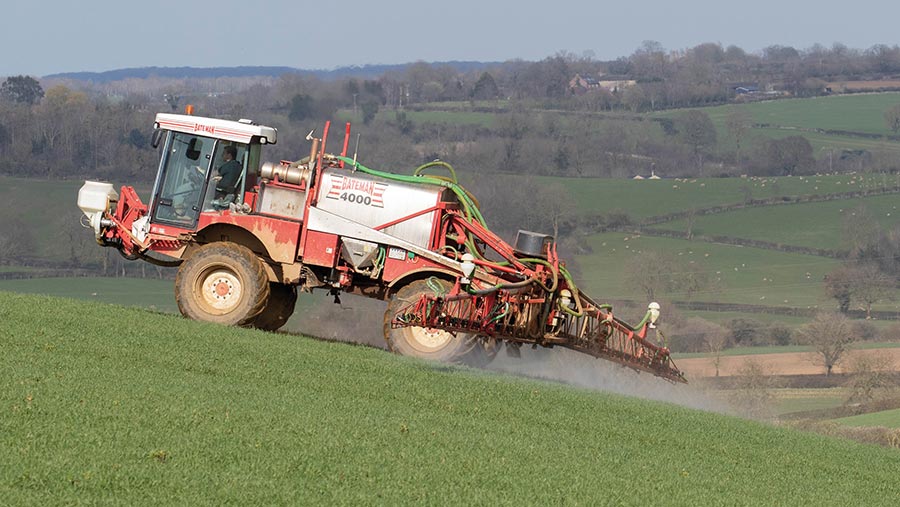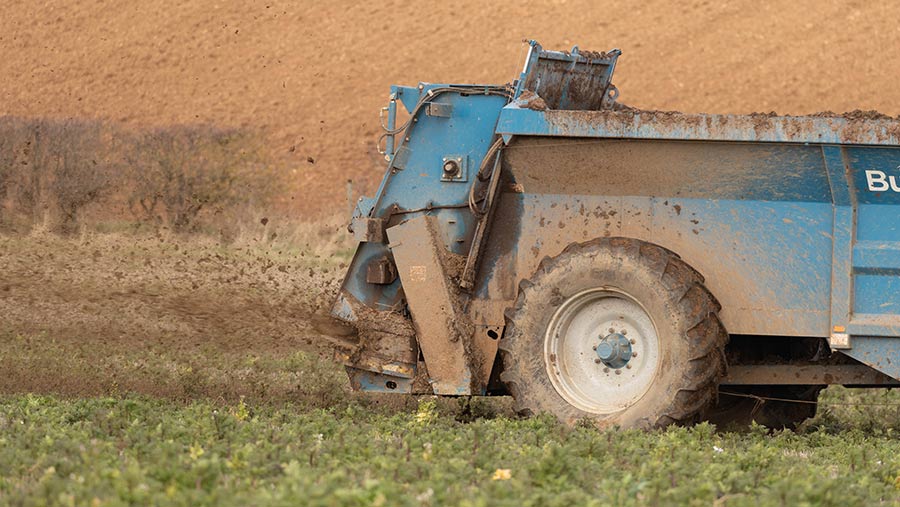Crop Watch: Spring sun brings rising disease pressure
 © Tim Scrivener
© Tim Scrivener Last week’s fine weather and unseasonably warm temperatures in most parts of the UK allowed much progress in spring drilling and other fieldwork.
The warmth has also accelerated growth of winter cereals and oilseed rape, with OSR nearing flowering. But the downside is that disease pressure is rising in some crops.
East
Marcus Mann
Frontier (Essex)
What a difference a week of fine dry weather can make. Field work has progressed at pace, spring drilling is complete and winter crops have woken up and are starting to move their early spring growth stages.
Oilseed rape is stem extending with buds raising above the canopy. At the green bud stage, OSR is at its most susceptible to pollen beetle damage. However, at present the levels remain below threshold.
See also: Why composting could help with new autumn manure rules
Remember, once the crop flowers, they will congregate on these and move from a pest to a beneficiary very quickly.
Crops struggling with cabbage stem flea beetle larvae and pigeon damage will be the more susceptible due to a later flowering period which may coincide with higher pollen beetle activity.
With warming temperatures, disease pressure is increasing and susceptible varieties are showing signs of light leaf spot.
Treatment is very much protective and must be applied at early signs of disease pressure.
This year, with restricted availability of further nitrogen as well as high prices, it is important to monitor on-farm stocks as you move through the season, to ensure it is used as efficiently as possible and allocated to crops based on their specific requirements.
It is also an opportunity to adapt current strategies, for example reducing pre-flowering applications in OSR to apply as a foliar after final petal fall.
Leaf 4 emerging
Wheat crops have benefited from early applications of nitrogen, with most now looking a nice vibrant green. The most forward crops are beginning to reach the true T0 timing with leaf 4 emerging.
Given the mild winter, septoria is easily found in the base of most crop canopies. As you would expect, the highest levels of infection are confined to varieties with the lower resistance ratings, for example Elation.
It is important to keep in mind that a lot of septoria ratings were downgraded last year, and not just those with Cougar in their parentage.
Unlike yellow rust, treatment for septoria at this stage is rarely cost effective. However, disease levels will be monitored closely ahead of making T1 recommendations.
Due to the milder winter and lack of significant frosts, yellow rust is active in susceptible varieties such as Zyatt and Kerrin. Unlike septoria, later drilled, backward crops can be more susceptible.
Similarly, stressed crops are more predisposed to disease, so correcting early nutrient deficiencies is important. It is imperative that rust levels are not allowed to build up, in order to avoid “firefighting” treatments later in the season.
While more than half the current recommended varieties offer resistance to yellow rust at the young plant stage, we all know that the yellow rust pathogen population is diverse and can change rapidly, along with resistance ratings.
All varieties must be monitored closely.
Winter barley continues to show high levels of net blotch and, in hybrid varieties, brown rust. Early treatments have been made, but crops may still require robust T1s if the disease pressure continues.
North
Patrick Stephenson
AICC (Yorkshire)
Getting sunburnt in March is a bit of a novel experience. The temperature gauge nudged 20C on several occasions last week and it was agronomists’ heaven as wellingtons were discarded.
Conditions were near perfect for spring drilling and clients have certainly been making the most of it.
It is impossible to avoid the ongoing conversation about nitrogen, as we all try to get to grips with the cost and potential supply issues.
For many growers, reducing totals by 30-40kg/ha is likely to have only a small impact on yield, and in many instances none.
We try to create an exact science for nitrogen requirements and sadly there is still a lot of guesswork.
Historically, we have been on the side of caution by putting on a little bit extra, assuming every crop will be above the RB209 averages.
The early-drilled winter wheat crops are now approaching growth stage 30 and the first split of a growth regulator programme is due.
As a rule of thumb, if a sulfonyl urea grassweed herbicide has been used, there is enough crop check for the growth regulator not to be split and the main timing to coincide with T1 fungicides.
Winter barley crops are at growth stage 30 and stem elongation has started. The first fungicide is now due on and will be based around prothioconazole.
Mildew and brown rust are the main diseases, with the hybrids exhibiting a ginger hue.
Growth regulator
A robust growth regulator programme is also planned, with a chlormoquat and trinexapac mixture being my favoured choice.
The main dilemma in winter barley crops is the timing of wild oat control: Do you go early and risk missing some, or go later and have tank mix and timing issues?
Each year I juggle this dilemma and nearly always have some firefighting. I now have stopped applying pre-emergence sprays to the spring barley as we hit April.
Crop effects and dry seed-beds mean to me that there is little net benefit.
Oilseed rape crops are now limping into flower and a product spectrum fungicide has been prescribed for when the crop is yellow all over the field.
I see no justification for pollen beetle sprays on most crops. Poor persistency, resistance issue and the loss of beneficials are the reasons behind this approach.
Winter beans look majestic and are starting to grow away. Broad-leaved weeds are hard to find, which means there is little or no need for my usual internal battle on the use of bentazone.
Every time I say the product is useless it works, and every time I think it will work it doesn’t.
After many years of trying to control Bruchid beetle I have declared a peace treaty and will no longer risk killing bees and let nature take its course.
In terms of agronomic decisions this leaves chocolate spot and rust, which will be monitored and targeted after flowering has started.
South
Oliver Bennetts
Zantra (Kent)
The improved spring weather over the past couple of weeks, with barely any rain to speak of, means farms in the area have grabbed the opportunity and have been able to near enough finish drilling their spring cereals.
While seed-beds have been warming up with the unusually high daytime temperatures for March, the soil still has plenty of moisture under the surface, which means seeds are chitting and throwing roots down quickly.
As for winter cereal crops, the wheat T0s are now being applied. Wheat crops currently are looking clean. I have only seen a few patches of rust in the area on certain varieties.
While these are few and far between, because of the variety mix in the area (dominated by Group 1 millers) I feel more comfortable to get the treatments on with a good, rust-active azole in the mix.
Because of the high percentage of milling wheat grown in the area, more nitrogen is being applied in order meet protein specifications, which means a robust plant growth regulator is included.
Most farms have now got their first main dose of nitrogen on and, with the heavy dews and the few light showers we have had, the nitrogen has made its way down into the root zone and is now being picked up by the winter cereals, which are really starting to green up. Longer and, hopefully, warmer days should see a real shift in growth.
Oilseed rape
Some early-drilled oilseed rape is fast approaching flowering in the area, with a small hint of yellow dotted across fields.
Farmers either drilling early last year or late, trying to miss the “flea beetle hotspot time” which has led to some failed crops that were drilled in the early part of September.
Still in the early drilled OSR, fungicides/PGRs are going on or have already gone on.
With such a valuable crop, we are looking to protect it as best we can, although the pigeons have had other ideas and with a reduced area of OSR they are taking their chances where possible.
Winter beans are starting to push on and spring beans are emerging or just starting to chit. We are on course to see crops have a good year, weather allowing.
Early potato planting is just around the corner, and we are preparing with cultivation, seed-bed fertiliser and de-stoning over the past week or so.
Plans for residual herbicides are being talked over, with pendimenthalin, prosulfocarb and aclonifen all in the frame at the moment.

© Tim Scrivener
West
Giles Simpson
Pearce Seeds (Somerset)
With the weather now on our side, the drills have been in action on all but the very heavy land. Generally, the seed-beds are very good.
Hopefully, by the time you read this the drills will be in action on the heavier land and the spring cereal drilling campaign will be nearly done.
Ground destined for maize is being sprayed off and mucked in preparation for cultivations to start in a few weeks’ time.
Be patient and wait until the soil is 10C and rising before drilling conventionally. Under film will be earlier, but again, be patient.
Hopefully, soil has been tested to see what the pH, P and K are and the muck is being applied evenly and recorded as to how much and where it has been spread. It’s too valuable a commodity to waste.
The winter cereals have now mostly received some fertiliser, even if the amount applied has been reduced due to cost and quantity available.
Winter wheats are relatively clean from septoria, but yellow rust has started to appear so this will be dealt with in the T0 spray application on more susceptible varieties.
Extase is looking disappointing at the moment.
Winter barley
Winter barleys are variable according to soil conditions, but the drier weather has helped, along with fertiliser.
Most have received an application of fungicide, PGR and trace elements and they are altering now. Wild oats have also been dealt with, or will be soon.
The OSR generally looks well, with limited pollen beetle showing so, hopefully, the potential is good.
Winter beans on one farm looked patchy, mainly due to soil conditions and rooks at emergence. The dilemma then was what to drill into the bare patches.
After much deliberation, we decided to drill spring beans. Although harvest date is going to be later, as the crop is destined for crimping to feed dairy cows, we will, hopefully, get away with it.
Time will tell, but leaving the acreage bare was not an option.
On some farms I have been asked if we should leave some fertiliser in the store for next year, as pricing and availability is unknown. If I had a crystal ball the answer would be easy. Unfortunately I don’t.
One of my customers told me this week giving advice was easy. I can assure you that it’s not, and over the next few months it is going to become increasingly more difficult.

